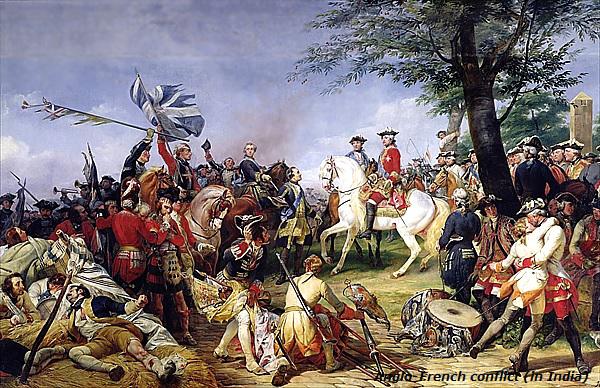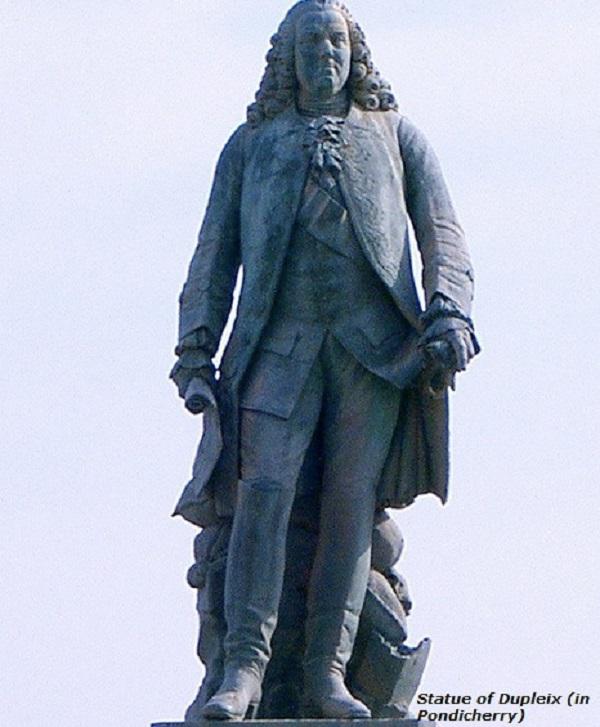In Southern India, however, conditions were gradually becoming favorable to foreign adventurers, as the central authority had disappeared there after the death of Aurangzeb (1707) and Nizam-ul-Mulk Asaf Jah (1748).
The Maratha chiefs regularly invaded Hyderabad and the rest of the South for collecting Chauth (tax).
The absence of central power gave the foreigners an opportunity to expand their political influence and control over the affairs of the South Indian states.
For nearly 20 years from 1744 to 1763, the French and the English were to wage a bitter war for control over the trade, wealth, and territory of India.
The French East India Company was founded in 1664. It made rapid progress and it was reorganized in the 1720's and soon began to catch up with the English Company.
It was firmly established at Chandernagore near Calcutta and Pondicherry on the East Coast.
The French Company had some other factories at several ports on the East and the West coasts. It had also acquired control over the islands of Mauritius and Reunion in the Indian Ocean.
The French East India Company was heavily dependent on the French Government, which helped it by giving it treasury grants, subsidies, and loan, etc.
The French East India Company was largely controlled by the Government, which appointed its directors after 1723.
The French state of the time was autocratic, semi-feudal, and unpopular and sniffled from corruption, inefficiency, and instability.
Instead of being forward-looking, it was decadent, bound by tradition, and in general unsuited to the times. Control by such a state could not but be injurious to the interests of the Company.
In 1742, war broke out in Europe between France and England. One of the major causes of the war was rivalry over colonies in America. Another was their trade rivalry in India. This rivalry was intensified by the knowledge that the Mughal Empire was disintegrating and so the prize of trade or territory was likely to be much bigger than in the past.
Anglo-French conflict in India lasted for nearly 20 years and led to the establishment of British power in India.
After defeated by France, the British appealed to the Nawab of Carnatic (in whose territory Madras was situated), to save their settlement from the French.
The Nawab sent an army against the French to stop the two foreign trading companies from fighting on his soil. And so the 10,000 strong armies of the Nawab clashed with a small French force, consisting of 230 Europeans and 700 Indian soldiers trained along Western lines, at St. Thorne on the banks of the Adyar River.
The Nawab was decisively defeated. This battle revealed the immense superiority of Western armies over Indian armies because of their better equipment and organization.
In 1748, the general war between England and France ended and, as a part of the peace settlement, Madras was restored to the English.
In the Carnatic, Chanda Sahib began to conspire against the Nawab, Anwaruddin, while in Hyderabad the death of Asaf Jah (Nizam-ul-Mulk), was followed by civil war between his son Nash Jang and his grandson Muzaffar Jang.
Dupleix seized concluded a secret treaty with Chanda Sahib and Muzaffar Jang to help them with his well-trained French and Indian forces.
In 1749, the three allies defeated and killed Anwaruddin in a battle at Ambur.
Carnatic passed under the dominion of Chanda Sahib who rewarded the French with a grant of 80 villages around Pondicherry.
In Hyderabad, the French were successful. Nasir Jung was killed and Muzaffar Jang became the Nizam or Viceroy of the Deccan.
Muzaffar Jang rewarded the French Company by giving territories near Pondicherry as well as the famous town of Masulipatam.
Dupleix stationed his best officer, Bussy, at Hyderabad with a French army. While the ostensible purpose of this arrangement was to protect the Nizam from enemies, it was really aimed at maintaining French influence at his court.
While Muzaffar Jang was marching towards his capital, he was accidentally killed. Bussy immediately raised Salabat Jang, the third son of Nizam-ul-Mulk, to the throne.
Salabat Jang, in return, granted the French the area in Andhra known as the Northern Sarkars, consisting of the four districts of Mustafanagar, Ellore, Rajahmundry, and Chicacole.
The French had started out by trying to win Indian states as friends; they had ended by making them clients or satellites. But the English had not been silent spectators of their rival's successes. To offset French influence and to increase their own, they (British) had been intriguing with Nasir Jung and Muhammad Ali.
In 1750, British decided to throw their entire strength behind Muhammad Ali.
Robert Clive, a young clerk in the Company's service, proposed that French pressure on Muhammad Ali, besieged at Trichinopoly, could be released by attacking Arcot, the capital of Carnatic. The proposal accepted and Clive assaulted and occupied Arcot with only 200 English and 300 Indian Soldiers.
Dupleix made strenuous attempts to reverse the tide of French misfortunes. But he was given little support by the French Government or even by the higher authorities of the French East India Company.
In the end, the French Government, weary of the heavy expense of the war in India and fearing the loss of its American colonies, initiated peace negotiations and agreed in 1754 to the English demand for the recall of Dupleix from India.
The temporary peace between the two Companies (British and France) ended in 1756 when another war between England and France broke out.
The French Government made a determined attempt to oust the English from India and sent a strong force headed by Count de Lally, it was all in vain.
The French fleet was driven off Indian waters and the French forces in the Carnatic were defeated.
The English replaced the French as the Nizam’s protectors and secured from him Muslipatam and the Northern Sarkar.
The decisive battle was fought at Wandiwash on 22 January 1760 when the English General Eyre Coot defeated Lally. The war ended in 1763 with the signing of the Treaty of Paris.
The French factories in India were restored but they could no longer be fortified or even adequately garrisoned with troops. They could serve only as centers of trade; and now the French lived in India under British protection.




